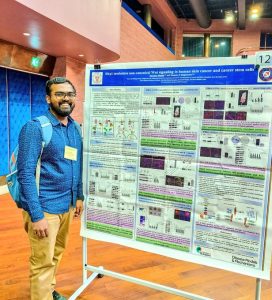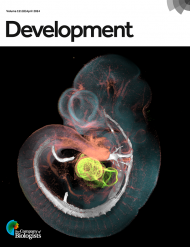10 August 2023

Darshan Mehta is a PhD student studying the mechanisms behind skin cancer at the Tata Memorial Centre Kharghar, Navi Mumbai, India. He took the opportunity to use a Conference Travel Grant from Disease Models & Mechanisms to travel to the 2023 Gordon Research Conference (GRC) on Stem Cells and Cancer – a meeting intended to explore cutting-edge research in the field of cell biology and cancer.
“The GRC meeting provided many opportunities to talk to eminent scientists in the field, including Elaine Fuchs, Cedric Blanpain and Geraldine Grausch” – Darshan Mehta, Disease Models & Mechanisms Conference Travel Grant recipient.
Darshan’s research focuses on understanding how certain pathways in human development play a role in cancer and the regulation of cancer stem cells. He’s particularly interested in a protein called SFRP1, which seems to influence the balance of skin cell growth, skin cancer development and how cancer stem cells behave. This protein has been found to be more active in certain stem cells in mice compared to non-stem cells. Darshan’s work has shown that, when SFRP1 levels are reduced, tumours can start growing earlier, and the behaviour of cancer stem cells changes.
Interestingly, these findings from studying mice were confirmed when looking at different types of human cancers, such as skin, oral and breast cancer. When SFRP1 levels are low, the chances of survival in these cancers tend to be worse. The reason behind this seems to be related to a particular cellular signalling pathway called Wnt. When SFRP1 levels decrease, a specific part of this pathway becomes more active, which effects how cells grow and behave in both mouse and human skin cancers.
One important discovery Darshan’s research has made is a connection between SFRP1 and a protein called SOX-2. This knowledge could potentially be used to predict how cancer might progress and help doctors manage the disease more effectively in the future.
Darshan attended many talks during the meeting, which covered a range of topics, including the basic biology of epidermal stem cells during development, cancer, stem cell metabolism and stem cell plasticity. His own research featured amongst 90 posters showcasing current research across the field.
“It was also a great opportunity to interact and discuss future opportunities to work in that area of science”, Darshan said.
Darshan said the experience had boosted his confidence as an individual and researcher immensely. He received input into his own work that is helping him to design experiments that will help substantiate his data further. Because the conference was a vast gathering, it gave Darshan the opportunity to share ideas with people who have similar interests and who are already established in this area.








You must be logged in to post a comment.